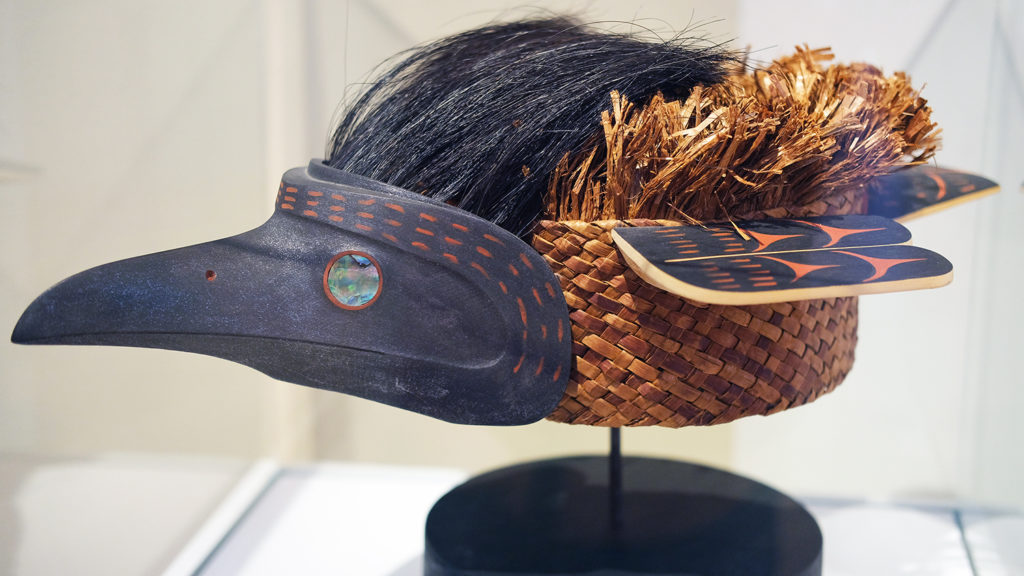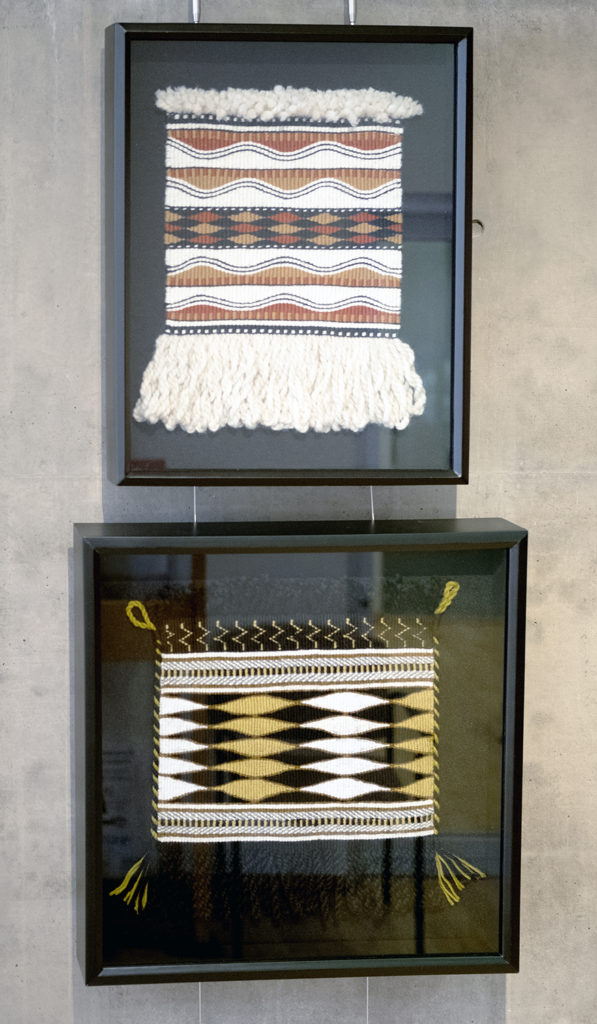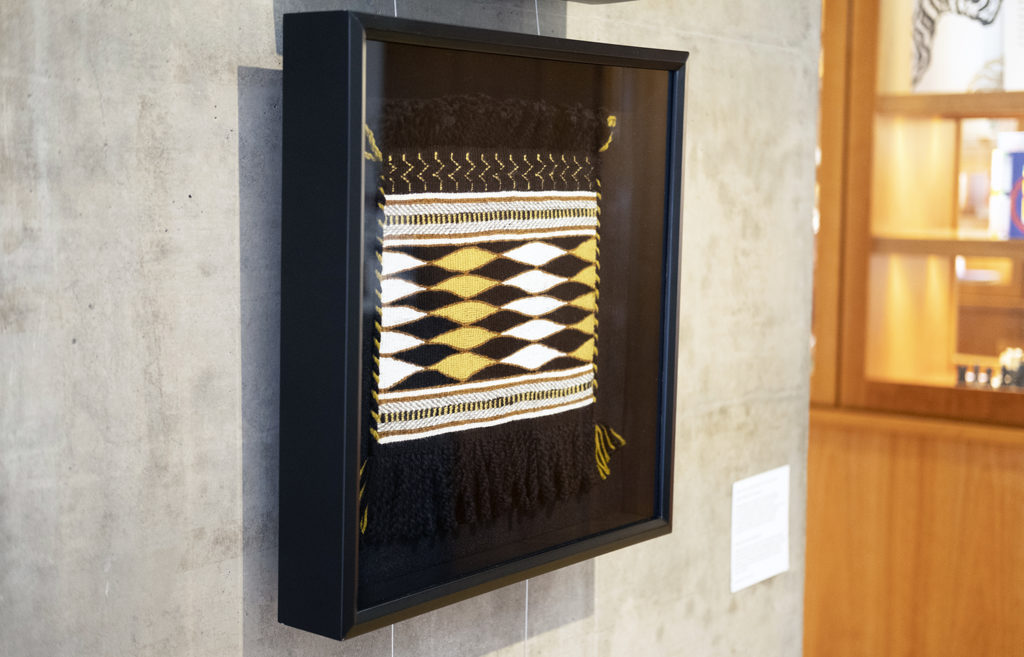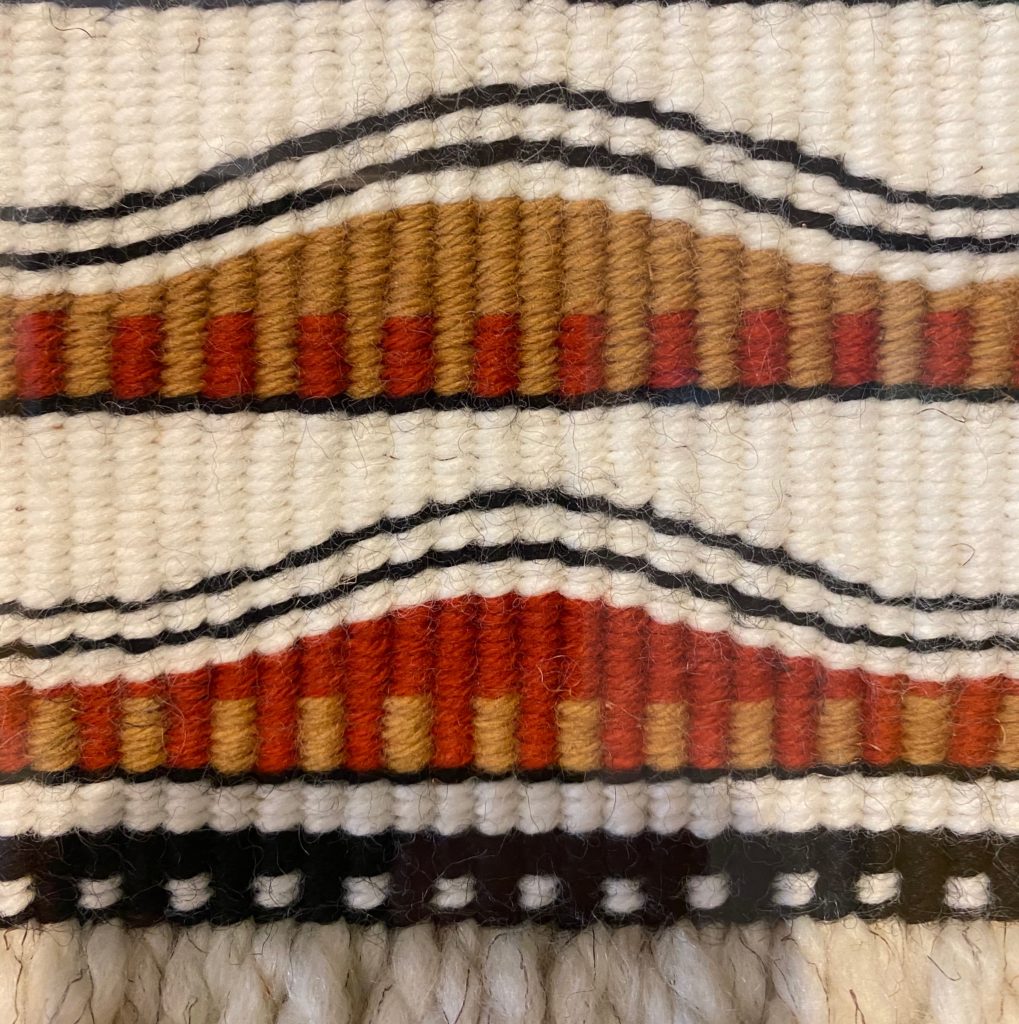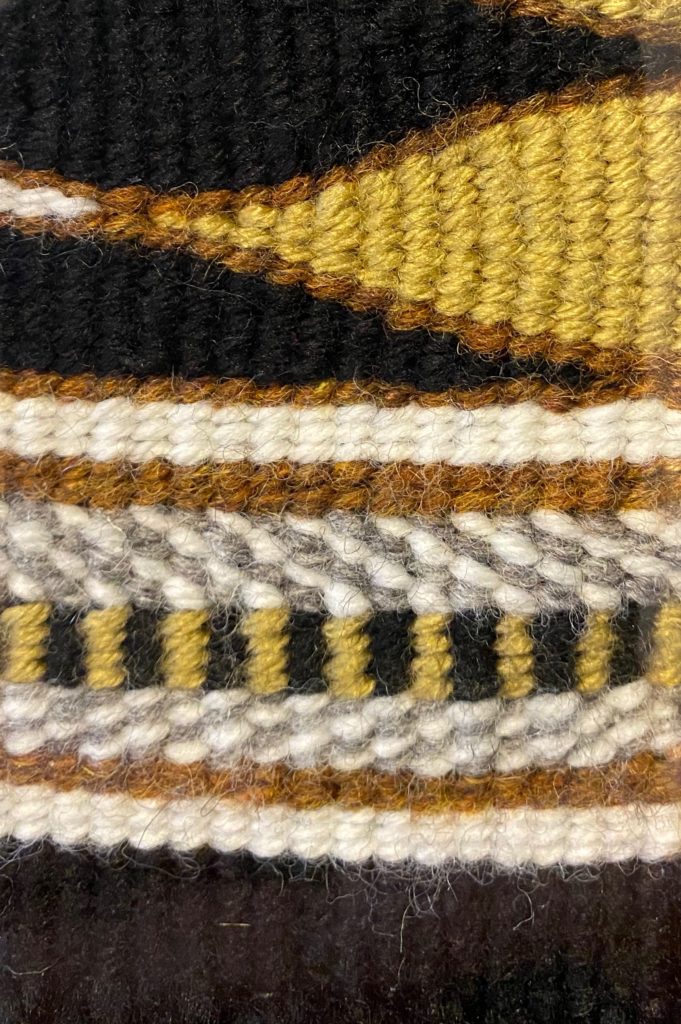
Interview with exhibiting artist Betty Pasco
Micaela Green, BIMA’s Membership and Museum Events Associate, got the opportunity to chat with exhibiting artist Betty Pasco recently to hear more about her and her fascinating work featured in BIMA’s current exhibition Fiber 2020. Betty Pasco is a Suquamish Tribal Elder, who works in Salish-style wool weaving, often using natural dyes made from local plants and lichens. The headdress on display is in collaboration with her husband Duane Pasco, a local artist and wood-carver. Check out the full interview below!
Betty, what can you tell us about you and your work?
My husband is an artist of Northwest Native art, studying mainly by visiting museums in Canada and the U.S. There were no books or galleries back in the time of his research. There were few people, mostly Native, seeking knowledge at that same time and the few became fast friends, together seeking artifacts in museums for this was their only way of learning, as there were no old teachers left to teach.
The art I do is to honor the ancestral weavers whose works are left in museums. Having a basic bit of knowledge of spinning, wool dying and the Salish style of weaving has me in awe of the weavers of the past. Do their designs have meaning, are songs sung while weaving, who is the weaving made for, what do the vibrant colors represent and what natural materials were used to achieve the dye? My message is that my weavings are a glimpse of the past and there is so much knowledge in the ancestor’s weavings that we will never know.
From whom have you learned most about art-making… and storytelling?
My grandmother wove cedar and spun wool to knit but never offered to teach her children or grandchildren. There was no storytelling in our quiet house.
I met my husband when I was the age of sixty two. He was creating art, interested in the culture of the many peoples of the world, spoke many languages, knew the history of all cultures of the Pacific Northwest and the world. He is constantly relating information about everything. He encouraged me in weaving and I signed up to take a two day class from Susan Pavel in natural dying and used the dyed wool to weave a twelve inch square Salish weaving. I was hooked and Duane encouraged me to weave. He already had books on every kind of weaving. He built me looms of every size. My husband is my inspiration and I have never considered myself a storyteller.
The headdress on display at BIMA is a collaboration with your husband, Duane. Can you speak to the collaborative process between you two during the creation of this piece? Can you also to speak the inspiration of this piece?
Not learning the traditional ways of gathering materials and preparing them, my sister and I went to a place grandma gathered sweetgrass. We were told we could gather enough to fill a plastic garbage bag full. When we arrived at the gathering place there were other weavers there gathering. We saw how they took the reeds from the plant and we copied what they did, filled our bag and headed home. I remember how grandma washed her grass and using an old wringer washer, ran the reeds between the rollers to press the water out of the reeds. Alone the next morning I set about to wash the reeds with a water hose. Having no wringer washer I used a rolling pin to press the water out of the reeds. My sister’s yard is surrounded by tall cedar trees. The crows landed in the trees where I was working. They started “cawing” at me as I worked. I thought of grandma, who had long passed. I smiled and said out loud “OK grandma, I’m doing the best I can”. I felt all my weaver ancestors were up there taunting and laughing at me. When I told this story to my husband, he said, “They are your “Spirit Helpers”. Well, he decided to carve me a canoe that would be mine and name it “Flock of Crows” in the Lushootseed language. When he finished the canoe, he said I needed a frontlet to wear in the canoe. Duane said he would carve the crow frontlet and would I weave the headband that the carving would be attached to. So I did weave the headband, lined it with felt and sewed a calico cloth liner which makes it comfortable to wear. So that’s the story of the frontlet headband. It really goes with the canoe but we couldn’t get the canoe in the elevator or up the stairs for the exhibit.(kidding)
What aspects of your artistic process are critical to you, from which you never deviate?
I do not deviate from an old pattern such as the Skokomish “dog” design, the “unfolding fern”, the “connecting spirits” designs and other named designs i would not change but there are designs that have no interpretation that I have used for my own interpretation, such as my “pawning salmon” robe that is on display at the Suquamish Museum. I don’t think there is an aspect of my art that I wouldn’t consider deviating from. How would one progress or improve any effort or skill we embark on?
You have talked about recreating patterns from weavers 200 years ago or so, but also not knowing the specific stories. Where is your heart and mind while working with these patterns? Why is it important to work with these older patterns?
Looking through books of older weavings, there were two that I was especially drawn to. The colors used, the flowing pattern designs and the composition of the whole along with the fine weaving technique made me want to put my hands to her work. I wanted the connection. I believe every artist takes inspiration from another artist and learns from replicating the piece and/or the other artist’s style.
You lived away from the Puget Sound area for more than thirty years before returning—have any of these places had any influence on your work?
While married to my Navy career husband took me to many places on the East Coast and Midwest, I never felt compelled to search out cultures or art of the regions. I was too busy raising my children. I wasn’t doing much of any art. I was sewing clothing for my school-aged children. I have not related my travels in the weavings I do today.
Describe a perfect day for you.
A perfect day for me and I would hope for any artist, would to be surrounded by children wanting to learn. My sister and I mentored a girls group, teaching them some of what we learned from our grandmother. (Remember, our grandmother never offered to teach us anything. As a grandma, I wanted to share whatever I knew.) The girls were from the ages of ten to sixteen. This was for Indian girls, “coming of age”. We cooked fry bread, dug clams on the beach, made clam chowder, wove cedar bark strips into little baskets, quilted baby blankets for the Tribal foster care babies, wove wool regalia and their own dresses to wear to the” Gathering of Nations” in Albuquerque. The girls organized fundraisers through yard sales and one fundraising salmon dinner with performers to sing and dance to raise funds for the trip to N.M.They loved the canoe my husband had carved. They practiced two or three times a week in all weathers and practiced “cold water training” by tipping the canoe over and righting it, bailing it out and being under way in less than 15 minutes. They paddled it (native style) kneeling on the bottom of the canoe the whole 31 mile “Paddle to Tulalip” as the first all girl’s canoe, the youngest crew and wearing the Salish woven dresses and headbands they wove themselves. Needless to say they were a hit. One girl, a 14 year-old was dancing in the bow, arms outstretched sprinkling eagle down on the water (to calm the waters) as they paddled before the viewing stand.The swell of the ovation they received as they came into view brought tears to our eyes as Duane and I watched from the support boat out on the water.
Eager to learn is the hook for me. These girls (all young ladies today)were great then and are all role models in our tribal community today.
My second “perfect day” would be to sit at the knee of the weavers of the past.
What are you working on next?
I am at this time working on a project for a gallery in Seattle. The theme of the show is “Salish Sea.” My weaving won’t be anything like the one at BIMA.
Lastly, as an artist, why is it important for members to continue to support arts organizations such as BIMA?
The importance of BIMA is much more than a history lesson. BIMA opens your mind to worlds of imagination. Each exhibitor in the Fiber Art show has a story to tell. I would think it would make a fascinating book or video, made for a child to awaken his imagination. Just as I wonder about the weaver who wove the robes I so admire from three hundred years ago, I wonder about the mind of the fellow who saw all those life forms in the feathers and then cut them out so precisely to set them free to their own possibility. I love the mind of an artist.
Published
Share
